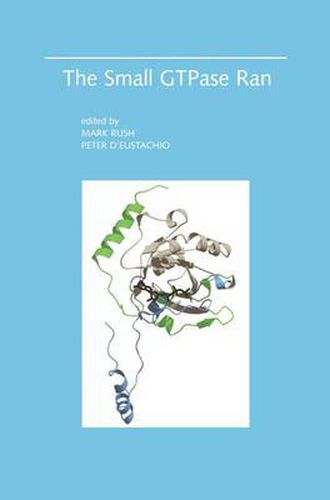Readings Newsletter
Become a Readings Member to make your shopping experience even easier.
Sign in or sign up for free!
You’re not far away from qualifying for FREE standard shipping within Australia
You’ve qualified for FREE standard shipping within Australia
The cart is loading…






This title is printed to order. This book may have been self-published. If so, we cannot guarantee the quality of the content. In the main most books will have gone through the editing process however some may not. We therefore suggest that you be aware of this before ordering this book. If in doubt check either the author or publisher’s details as we are unable to accept any returns unless they are faulty. Please contact us if you have any questions.
RAN: AN ATYPICAL GTPASE Mark G. Rush and Peter D'Eustachio New York University School o/Medicine. Department,o/Biochemistry New York NY 10016 ABSTRACT GTPases, proteins that bind and hydrolyze GTP (guanosine triphos- phate) are critical regulators of many metabolic pathways. Although these proteins are enzymes that catalyze the hydrolysis of GTP to GDP + Pi, their primary function is not the hydrolysis of GTP per se, but rather the coupling of this hydrolysis to metabolic regulation. Such coupling is gen- erally achieved through the interaction of the GTP-bound form of the GTPase with proteins known as *effectors. Effectors are often enzymes whose activities are modulated by the GTPase. However, effectors can also be structural proteins involved in assembling intracellular macromo- lecular complexes, such as actin filaments and microtubules, as well as proteins involved in the intracellular transport of proteins and RNAs. In- deed, the subject of this anthology, the small GTPase Ran, may exert most or all of its regulatory functions by interacting with non-enzyme effectors. This property of Ran distinguishes it from other well studied GTPases, and has resulted in the elucidation of novel mechanisms of Ran action that are quite distinct from previously established paradigms of GTPase function. 1. INTRODUCTION The Ras-related nuclear protein Ran is a highly conserved (80% identity among yeasts and humans) member of the Ras superfamily of small GTP binding and hydrolyzing proteins.
$9.00 standard shipping within Australia
FREE standard shipping within Australia for orders over $100.00
Express & International shipping calculated at checkout
This title is printed to order. This book may have been self-published. If so, we cannot guarantee the quality of the content. In the main most books will have gone through the editing process however some may not. We therefore suggest that you be aware of this before ordering this book. If in doubt check either the author or publisher’s details as we are unable to accept any returns unless they are faulty. Please contact us if you have any questions.
RAN: AN ATYPICAL GTPASE Mark G. Rush and Peter D'Eustachio New York University School o/Medicine. Department,o/Biochemistry New York NY 10016 ABSTRACT GTPases, proteins that bind and hydrolyze GTP (guanosine triphos- phate) are critical regulators of many metabolic pathways. Although these proteins are enzymes that catalyze the hydrolysis of GTP to GDP + Pi, their primary function is not the hydrolysis of GTP per se, but rather the coupling of this hydrolysis to metabolic regulation. Such coupling is gen- erally achieved through the interaction of the GTP-bound form of the GTPase with proteins known as *effectors. Effectors are often enzymes whose activities are modulated by the GTPase. However, effectors can also be structural proteins involved in assembling intracellular macromo- lecular complexes, such as actin filaments and microtubules, as well as proteins involved in the intracellular transport of proteins and RNAs. In- deed, the subject of this anthology, the small GTPase Ran, may exert most or all of its regulatory functions by interacting with non-enzyme effectors. This property of Ran distinguishes it from other well studied GTPases, and has resulted in the elucidation of novel mechanisms of Ran action that are quite distinct from previously established paradigms of GTPase function. 1. INTRODUCTION The Ras-related nuclear protein Ran is a highly conserved (80% identity among yeasts and humans) member of the Ras superfamily of small GTP binding and hydrolyzing proteins.